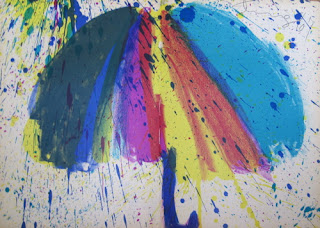The painter and lithographer Walasse Ting, who died earlier this year, occupies a unique place in the dialogue between American and European art in the 1960s. Ting was an outsider to both cultures. He was born Ding Xiongquan in Shanghai in 1929. After studying briefly at the Shanghai Art Academy, he left China in 1946, living initially in Hong Kong before sailing to France in 1950. In Paris, Walasse Ting came under the influence of the artists who made up the avant-garde group CoBrA, most notably Pierre Alechinsky, Karel Appel, and Asger Jorn. In 1958, Ting moved to America, where his closest associate was the Abstract Expressionist painter Sam Francis. In 1964, Walasse Ting and Sam Francis collaborated on one of the greatest artist’s books of the period, a collection of Ting’s stream-of-consciousness Pop Art poems illustrated with original lithographs by a total of 28 artists, entitled One Cent Life. Unfortunately I don’t have a copy of this, but it’s a remarkable work, and particularly notable for the way in which it mixes the slick Pop Art of Americans such as Andy Warhol with the turbulent work of the CoBrA artists. Whereas in the USA Pop Art concerned itself largely with surfaces, as a comment on consumerism, in Europe it concerned itself with structures, as a critique of consumerism. A typical CoBrA work is a violent, semi-abstract, distorted, highly-sophisticated version of a child’s drawing. There are echoes of folk art and tribal art, and a sense of rejection of society’s falsely-imposed sense of order and respectability. Walasse Ting could straddle both these worlds, and it is largely due to his One Cent Life that one can even speak of a single Pop Art movement, embracing both the Americans and the Europeans.
Pierre Alechinsky. Hommage à Aimé et Marguerite Maeght
Lithograph, 1982
Sam Francis, Noise
Lithograph, 1989
Walasse Ting, Untitled composition 1
Lithograph, 1963
Walasse Ting, Untitled composition 3
Lithograph, 1963
Walasse Ting, Untitled composition 6
Lithograph, 1963
Walasse Ting, Untitled composition 9
Lithograph, 1963
My first Walasse Ting lithographs are all untitled compositions from the catalogue to his 1963 exhibition at the Galerie Birch in Copenhagen. The lithographs were printed by Permild and Rosengreen.
Wallace Ting, Butterfly gun
Lithograph, 1967
Walasse Ting, Iris bursting
Lithograph, 1967
Walasse Ting, Singing in the rain
Lithograph, 1967
Walasse Ting, Twinkling star
Lithograph, 1967
My next group of lithographs, also printed by Permild and Rosengreen, were made in 1967 for Walasse Ting’s collection of classical Chinese poetry, in his own translations, Chinese Moonlight. The lithographs were bound into the book, so have a central vertical fold and minute thread holes; on the plus side, all four of mine are boldly signed in pencil Ting ’67; the book is additionally inscribed by Ting to John Schiff.
Walasse Ting, Someone make love
Lithograph, 1969
Walasse Ting, Love is many splendored thing
Lithograph, 1969
Walasse Ting, Male order
Lithograph, 1969
Walasse Ting, Chicken chow mein
Lithograph, 1969
Walasse Ting, Rainbow as thread
Lithograph, 1969
Walasse Ting, Dedicated to all prostitutes in the world
Lithograph, 1969
My final Walasse Ting lithographs, printed by Bjørn Rosengreen and published by the Sam Francis Foundation, come from his poetry collection Hot & Sour Soup. My copy of this was inscribed by Ting to the influential art critic of the New York Times, “To John Canaday, Sunshine as best wishes, moonlight as desert, from Walasse Ting 22 October 1969 NYC”.
Walasse Ting, Dragonflies mating
Ink drawing, 1969
And last of all I have a single Walasse Ting ink drawing, boldly drawn on a blank page of Hot & Sour Soup for John Canaday.
Walasse Ting, 1929-2010
Photographed in 1963
In his later years Wallace Ting lived in Amsterdam, making frequent trips to both New York and Tahiti. He ceased painting in 2002 after suffering a severe stroke, and died in New York on May 17, 2010.














































